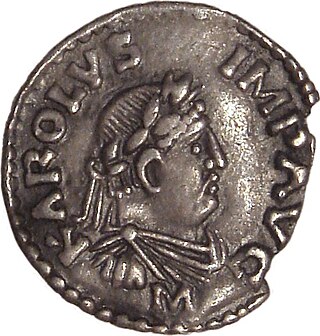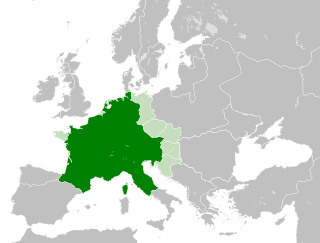Related Research Articles

Charlemagne was King of the Franks from 768, King of the Lombards from 774, and Emperor of what is now known as the Carolingian Empire from 800, holding these titles until his death in 814. He united most of Western and Central Europe, and was the first recognised emperor to rule from the west after the fall of the Western Roman Empire approximately three centuries earlier. Charlemagne's reign was marked by political and social changes that had lasting influence on Europe throughout the Middle Ages.
Pope Adrian I was the bishop of Rome and ruler of the Papal States from 1 February 772 until his death. He was the son of Theodore, a Roman nobleman.
The 770s decade ran from January 1, 770, to December 31, 779.

The year 771 (DCCLXXI) was a common year starting on Tuesday of the Julian calendar. The denomination 771 for this year has been used since the early medieval period, when the Anno Domini calendar era became the prevalent method in Europe for naming years.

The Carolingian Empire (800–887) was a Frankish-dominated empire in Western and Central Europe during the Early Middle Ages. It was ruled by the Carolingian dynasty, which had ruled as kings of the Franks since 751 and as kings of the Lombards in Italy from 774. In 800, the Frankish king Charlemagne was crowned emperor in Rome by Pope Leo III in an effort to transfer the status of Roman Empire from the Byzantine Empire to Western Europe. The Carolingian Empire is sometimes considered the first phase in the history of the Holy Roman Empire.

Carloman I, German Karlmann, Karlomann, was king of the Franks from 768 until his death in 771. He was the second surviving son of Pepin the Short and Bertrada of Laon and was a younger brother of Charlemagne. His death allowed Charlemagne to take all of Francia.

Desiderius, also known as Daufer or Dauferius, was king of the Lombards in northern Italy, ruling from 756 to 774. The Frankish king of renown, Charlemagne, married Desiderius's daughter and subsequently conquered his realm. Desiderius is remembered for this connection to Charlemagne and for being the last Lombard ruler to exercise regional kingship.

The siege or battle of Pavia was fought in 773–774 in northern Italy, near Ticinum, and resulted in the victory of the Franks under Charlemagne against the Lombards under King Desiderius.
Himiltrude was the mother of Charlemagne's first-born son Pippin the Hunchback. Some historians have acknowledged her as the wife of Charlemagne, though she is often referred to as a concubine.

Bertrada of Laon, also known as Bertrada the Younger or Bertha Broadfoot, was a Frankish queen. She was the wife of Pepin the Short and the mother of Charlemagne, Carloman and Gisela, plus five other children.

Pepin or Pippin, was King of Italy from 781 until his death in 810. He was the third son of Charlemagne. Upon his baptism in 781, Carloman was renamed Pepin, where he was also crowned as king of the Lombard Kingdom his father had conquered. Pepin ruled the kingdom from a young age under Charlemagne, but predeceased his father. His son Bernard was named king of Italy after him, and his descendants were the longest-surviving direct male line of the Carolingian dynasty.

Hildegard was a Frankish queen and the wife of Charlemagne from c. 771 until her death. Hildegard was a noblewoman of Frankish and Alemannian heritage. Through eleven years of marriage with Charlemagne, Hildegard helped share in his rule as well as having nine children with him, including the kings Charles the Younger and Pepin of Italy and the emperor Louis the Pious.
Charles the Younger was the son of the Frankish ruler Charlemagne and his wife Queen Hildegard. Charlemagne's second son, Charles gained favour over his older, possibly illegitimate half brother Pepin. Charles was entrusted with lands and important military commands by his father. In 800, Charlemagne was crowned emperor by Pope Leo III, and during this ceremony Charles was anointed a king. Charles was designated as the heir of the bulk of Charlemagne's lands but predeceased his father, leaving the empire to be inherited by his younger brother Louis the Pious.

Adalgis or Adelchis was an associate king of the Lombards from August 759, reigning with his father, Desiderius, until their deposition in June 774. He is also remembered today as the hero of the play Adelchi (1822) by Alessandro Manzoni.

Ansa was a noblewoman who became the Queen of the Lombards in 756 and reigned until their fall to the Franks in 774 AD. She, like other Medieval Queens at the time, played a significant role in the stability and preservation of the later Lombard Kingdom, particularly through her religious contributions, donations, and political relationships with neighboring Kingdoms. She reigned alongside her husband, King Desiderius, in Northern Italy. She lived her final years exiled to a monastery until her death.
Pepin, or Pippin the Hunchback was a Frankish prince. He was the eldest son of Charlemagne and noblewoman Himiltrude. He developed a humped back after birth, leading early medieval historians to give him the epithet "hunchback". He lived with his father's court after Charlemagne dismissed his mother and married Desiderata. Around 781, Pepin's half brother Carloman was rechristened as "Pepin of Italy"—a step that may have signaled Charlemagne's decision to disinherit the elder Pepin, for a variety of possible reasons. In 792, Pepin the Hunchback revolted against his father with a group of leading Frankish nobles, but the plot was discovered and put down before the conspiracy could be put into action. Charlemagne commuted Pepin's death sentence, having him tonsured and exiled to the monastery of Prüm instead. Since his death in 811, Pepin has been the subject of numerous works of historical fiction.
Gerberga was the wife of Carloman I, King of the Franks, and sister-in-law of Charlemagne. Her flight to the Lombard kingdom of Desiderius following Carloman's death precipitated the last Franco-Lombard war, and the end of the independent kingdom of the Lombards in 774.
Liutperga (Liutpirc) (fl 750 - fl. 793) was a Duchess of Bavaria by marriage to Tassilo III, the last Agilolfing Duke of Bavaria. She was the daughter of Desiderius, King of the Lombards, and Ansa.
Drogo was a Frankish nobleman of the Pippinid family and the eldest son of Carloman, mayor of the palace of Austrasia under the Merovingian king Childeric III. He succeeded to his father's office in 747 but was soon squeezed out of power by his uncle, Pippin III, the mayor in Neustria. He resisted his uncle's takeover, but in 753 was captured and forced to become a monk.
Autchar was a Frankish nobleman. He served Pippin III as a diplomat in 753 and followed Carloman I after the division of the kingdom in 768. In 772, refusing to accept Carloman's brother Charlemagne as king, he went into exile in the Lombard kingdom with Carloman's widow and sons. He was captured when Charlemagne invaded the kingdom in 773. His role in the fall of the Lombard kingdom was the subject of legendary embellishment a century later and in the chansons de geste he evolved into the figure of Ogier the Dane.
References
- ↑ Nelson, Janet L. (2007). Courts, elites, and gendered power in the early Middle Ages Charlemagne and others. Ashgate. ISBN 9780754659334. OCLC 1039829293.
- ↑ Carolingian civilization : a reader. Dutton, Paul Edward, 1952- (2nd ed.). Peterborough, Ont.: Broadview Press. 2004. ISBN 1551114925. OCLC 53822828.
{{cite book}}: CS1 maint: others (link) - ↑ Einhard, approximately 770-840 (2008-09-30). Two lives of Charlemagne. Ganz, David,, Notker, Balbulus, approximately 840-912. London. ISBN 9780140455052. OCLC 226280161.
{{cite book}}: CS1 maint: location missing publisher (link) CS1 maint: numeric names: authors list (link) - ↑ Nelson, Janet L. (2007). Courts, elites, and gendered power in the early Middle Ages Charlemagne and others. Ashgate. ISBN 9780754659334. OCLC 1039829293.